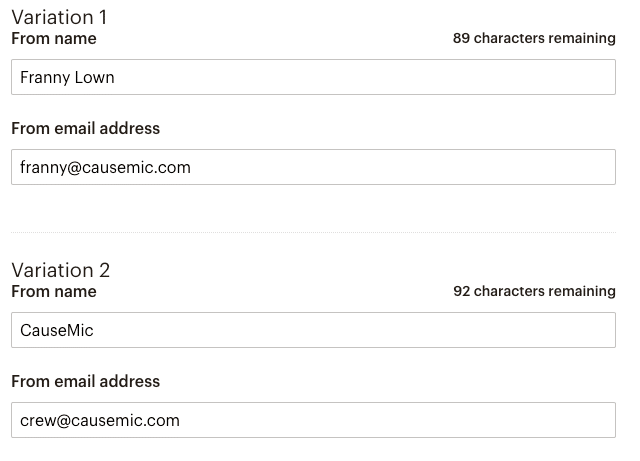A/B Testing: Optimize Your Email Marketing

When was the last time you re-evaluated your nonprofit email communications?
Considering email accounts for ⅓ of all online revenue, we’re strong proponents of optimizing this channel as a part of an omni-channel communications strategy. A/B testing is a great first step in the quest to improve deliverability and reach your supporters in an engaging and personalized way.
What is A/B Testing?
A/B testing, also known as split-testing, allows your organization to test different elements of your email marketing strategy to find what works best for your unique audience. Email service providers like Salesforce Pardot, ActiveCampaign, and Mailchimp can make A/B testing easy, allowing users to create two versions of the same email, with one element swapped out in order to test which version performs best. Whichever email wins the A/B battle based on higher click rates, donations, etc. for say, 20% of your audience (this will depend on what you want to track), that version will be served to the remainder of your audience segment.
When running tests to see which tactics appeal more to your audience, be sure to only test one element at a time. The testing process is a labor of love but offers a high reward as you slowly gain insight on how to best reach the people that make your work possible. It’s helpful to remember that there’s another human on the other end of your communications, so inspect each newsletter, appeal, update, etc. with an introspective lens. You wouldn’t call up a friend only to ask for favors, so consider asking your team, “would YOU want to receive this?”
1. Set a Goal
Start by setting a goal. What are you looking to measure? Do you want to track engagement like click-through rate or open rate? Conversions such as donations or volunteer sign ups? Depending on your goal and list size, it may take multiple tests over time to find an answer so don’t be discouraged if you don’t see major differences right away.
Once you’ve determined the metrics you’d like to track, create your testing plan. Prioritize what you want to know, and make sure you’ve assigned a team member to stay on top of your testing regimen so you can ensure consistent results. For example, once you’ve sent out a test email, it’s best to wait a couple hours to review your results before sending out a second batch. Factor in this time into your sending schedule so you know when to share round two.
2. Determine What to Test
There are so many elements that go into making a powerful email. Again, ensure you’re testing ONE thing at a time to collect accurate results on each aspect of your distribution process.
 Here’s an example from Mailchimp, which simplifies the testing process.
Here’s an example from Mailchimp, which simplifies the testing process.
Subject Line
First impressions can make all the difference, especially when you’re trying to conjure sign-ups or donations for your cause. Make an impact by positioning your supporter as the hero and communicate the purpose of the email at the same time, which is no easy feat. Examine the differences of these two examples:

Sender
When our team monitored email communications from 152 nonprofit organizations during year-end fundraising, we found 63% of organizations sent us emails directly from the organization overall, and only 5% of emails came directly from a person. We preach personalization at scale, so seeing a real email from a real human was a welcome shift in the sea of impersonal organization mass marketing blasts. Learn more about our findings and download the free report here.

Every organization is different, so test what works best for your audience over time. While some supporters may not know everyone on your team by name, they will become more familiar over time as they begin to recognize your names in their inbox. Consider interspersing emails directly from a staff member with emails from your organization, and a combination of both to find what works best.
Content
Arguably, this is the area where testing may take the longest. Once you’ve gotten your supporters to click on your email, are they engaging with what they read? You can change up the copy, color layout, or how you position your primary call-to-action. Try bringing your nonprofit brand to life with powerful imagery, and use of color palette. Or opt to pare it back and send a super-simplified personalized email directly from a person and see how your supporters respond. The options are endless here!
This is a great example from Call to Safety that feels like a real email from a real human, addressed personally to our crew.

Send Time
There’s a lot of data out there around the absolute best time to send nonprofit emails - but depending on your audience (factoring in multiple time zones, areas of interest, etc.) these metrics may or may not apply to you. So do some research, and put it to the test! Explore how shifting the time of day and day of the week impacts the metrics you’re trying to track.

Try sending a few emails over the weekends, or send your emails in batches depending on where your supporters live and what you’re trying to get them to do. If there is a timely response required, keep that in mind as you test this element.
Audience Segmentation
Segment your supporters to determine where your most engaged audience lies, and send to those folks first, as it can help increase email deliverability. You may segment your audience based on location, demographics (age, gender, occupation, etc.), interests, donation size, or status within your organization (donors, fundraisers, advocates, or supporters). If you’re switching up your audience, be sure to keep your emails consistent instead of testing variables between segments, which won’t tell you much!
3. Evaluate Results & Optimize
Determine how your audience responds to each element of testing, and then implement those practices in the future, keeping in mind that the time of year, type of email, and cadence are all factors that can impact your metrics.
Start small, assess your results, and run with what works. Happy testing!
Continue Learning
We're wild about email - and we wanted to see how nonprofits in our community measured up. So, we subscribed to 152 email newsletters and evaluated every engagement email that arrived in our inbox. Explore the practices already in play, read the full breakdown of how nonprofits measured up, and walk away with best-in-class tactics. All for free.





